Testosterone replacement therapy (TRT) is often lauded for its benefits but raises concerns about hair loss due to the role of dihydrotestosterone (DHT). Genetic predisposition plays a significant part, with DHT affecting those susceptible to hair thinning. Despite the benefits of TRT, understanding its link to hair health is important. Exploring both medical and natural solutions for managing hair loss offers a pathway to optimize TRT outcomes while preserving one’s appearance.
Understanding Testosterone Replacement Therapy (TRT) and Hair Loss
Testosterone replacement therapy (TRT) has gained attention for its potential side effects, particularly regarding hair loss. While TRT is not a direct cause of baldness, it is important to understand the indirect effects it may have. Dihydrotestosterone (DHT), a byproduct of testosterone, is traditionally linked to hair thinning and loss in those genetically predisposed to this condition. This occurs when testosterone converts into DHT, affecting susceptible individuals by accelerating hair follicle miniaturization.
Genetics and Hormonal Interactions
At the core of hair loss lies a genetic component. Over 95% of hair loss cases in men are due to androgenetic alopecia, a hereditary condition influenced by DHT. Genetics predetermine follicle sensitivity to DHT, leading to an increased risk of hair loss for some men undergoing TRT despite the therapy merely assisting to normalize testosterone levels. It is this genetic sensitivity, not TRT itself, that is the primary culprit in many cases.
Benefits and Risks of TRT
TRT offers numerous benefits, including improved energy levels, better weight management, and enhanced mental health. For men with clinically low testosterone, the advantages often outweigh the potential risk of hair loss. By addressing low testosterone symptoms, TRT can improve overall well-being and life quality, even if there is some risk involved in terms of hair health.
Managing Hair Loss on TRT
For those concerned about hair loss while on TRT, there are FDA-approved treatments available, such as finasteride, dutasteride, and minoxidil. These treatments may promote hair regrowth and maintain hair density by blocking DHT. Additionally, exploring natural remedies like rosemary oil or supplements can provide preventive care for those genetically susceptible to hair loss while on TRT.
Targeting DHT and Other Treatment Options
Beyond topical solutions, new approaches like low-level laser therapy or invasive procedures like follicular unit extraction (FUE) hair transplants present supplementary options. Platelet-rich plasma (PRP) injections, known for stimulating hair follicles, offer another promising treatment to manage hair thinning caused by DHT buildup due to TRT.
Personalized Medical Consultation
Undergoing TRT should be an informed decision where patients thoroughly assess potential benefits and risks with healthcare providers. It’s critical to confirm low testosterone levels and explore all possible causes of related symptoms, as the natural decline of testosterone with age may not always necessitate TRT unless indicated by medical tests confirming low levels.
Why You Should Learn More About TRT and Hair Loss Today
Understanding how testosterone affects hair health and exploring potential solutions requires a balance between knowledge and expert medical guidance. With the complexity of genetic predispositions and the overarching benefits TRT may offer, further exploration and discussion with healthcare providers can clarify uncertainties regarding hair loss. Whether you’re considering TRT or seeking solutions for hair preservation, a focused approach combining scientific understanding with personalized care is crucial.
Sources
Hormonal Influences on Hair Loss
Managing Hair Loss While Using TRT



